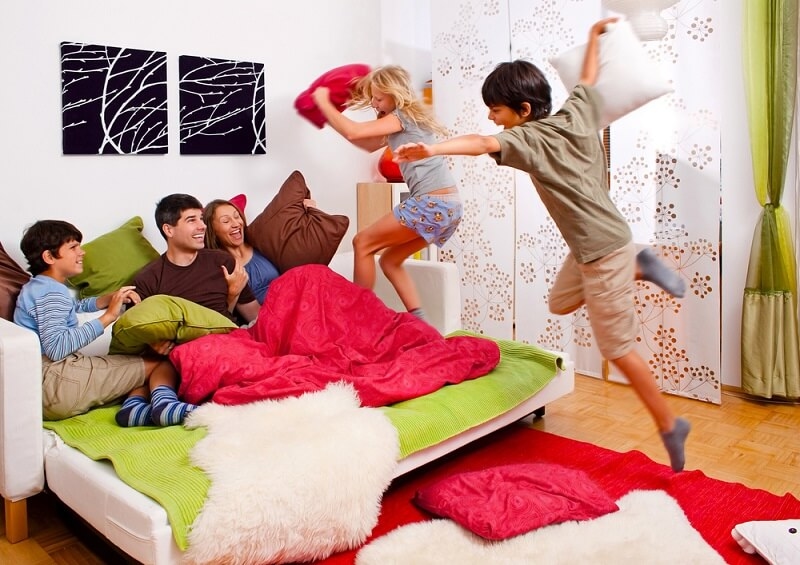
Every family tells a story — and lately, that story falls into two very revealing categories: living room families and bedroom families. This viral trend isn’t just about couches vs closed doors…it’s about connection, comfort, and what “home” really feels like behind the walls. The conversation is emotional, a little triggering, and deeply overdue. Because the way your family uses space? It says everything you never actually say out loud.
The living room family vs bedroom family debate exploded after parents online finally put a name to the unspoken differences in how households actually function. A living room family is exactly what it sounds like — the heart of the home lives out loud in the gathering space. Everything happens in the open: cartoons, tantrums, pizza nights, laundry piles nobody bothered hiding. The living room isn’t for guests — it’s for life.
On the flip side sits the bedroom family definition — a quieter, more compartmentalized setup. Kids spend most of their time in bedrooms: playing, scrolling, even eating. Living spaces stay neat on purpose. Toys are hidden, noise is capped, and you get invited to the couch only when it’s “family time.” In this setup, the bedroom family vs living room family meaning isn’t just about housekeeping… it’s emotional architecture. One welcomes chaos. The other contains it.
More to Discover: Family Health Essentials: Building Healthier Homes
Let’s go deeper into the bedroom family definition. In a bedroom family, individual rooms serve as personal headquarters with everything kids need to stay occupied and tucked away. Screens, snacks, games — it’s all there. In extreme cases, the bedroom becomes the main location a child spends their time, making family interaction something they have to leave their “zone” for. Parents often lean this way to preserve order, peace and quiet — especially when they crave cleanliness or grew up under strict norms. But it comes with a trade-off: less organic connection.
TikTok has been flooded with commentary from now-grown kids of bedroom families, unpacking the unintended side effects — feeling emotionally distant, figuring things out alone, or associating family rooms with judgment zones. That doesn’t mean bedroom families are cold or neglectful...it means the emotional messaging in the house often gets filtered through how shared space is (or isn’t) used.
The living room family trend surged because people felt seen. Suddenly, a messy couch covered in snack crumbs wasn’t a sign of laziness — it was proof of love in motion. In a living room family, the living room is a playground, therapist’s office, and snack bar all at once. Everyone is together, even when they’re doing their own thing. That closeness sends a loud emotional message: you belong…without needing to be perfect first.
Over and over, adults looking back on life describe their parents’ house as “one big living room” where they felt invited, not inspected. That’s what makes the living room family vs bedroom family conversation powerful — it's not about open-concept floorplans, it's about emotional permission to exist loudly.
The term hit the mainstream thanks to TikTok creators showcasing homes where the living room looked less like a catalog spread and more like an obstacle course of stuffed animals, LEGO landmines, and half-folded laundry. Instead of apologizing, these parents claimed their space with pride — birthing the living room family parenting trend.
Content creators racked up millions of views, pointing out that for years, we’ve been sold “perfect” living rooms with minimal décor, neutral tones, and no sign that children even live there. The living room family trend finally let parents exhale: a lived-in living room isn’t failure — it’s proof you’re doing it right.
Don’t Miss: Fitness Routines for Active Kids and Busy Parents

Kids in living room families feel safe expressing emotions — joy, boredom, or chaos — right in front of their parents. They grow up knowing they don’t have to retreat behind a door to exist comfortably around their family.
Instead of orchestrated sit-downs, bonding happens in the flow of daily life. That casual, unforced connection is one of the biggest benefits of living room family environments — kids talk more casually, parents pick up on moods sooner, and shared laughter doesn’t need to be scheduled.
Parents aren’t constantly fighting the urge to sterilize their homes. They’re living in it — not curating it like a rental listing. That permission leads to healthier mental space and less resentment around domestic life.
Many millennials who grew up in bedroom families and felt emotionally lonely are now building the opposite: loud, messy, living-room-heavy households. They’re healing their inner child by refusing to tuck real life behind bedroom walls.
The living room family isn’t just for families with toddlers. Even tweens and teens benefit from non-judgmental access to family spaces — knowing they have privacy if wanted, but never being banished to their rooms unless they choose it.
| Aspect | Living Room Family | Bedroom Family |
| Core Space | Living room as activity/bonding HQ | Bedrooms are individual hubs |
| Mess Factor | Chaos accepted | Mess hidden and isolated |
| Emotional Vibe | Included, connected, present | Independent, private, sometimes distant |
| Parenting Style | Flexible, responsive, present-in-the-moment | Structured, boundary-based |
| Kid Mindset | “I belong here” | “I stay in my space” |
| Family Rhythm | Organic interaction all day | Interaction scheduled or limited |
Neither approach is automatically better. A bedroom family can absolutely raise confident, stable children — especially if bedroom time is paired with intentional together-time and emotional presence. But when unintended distance creeps in, family members may begin to feel like polite roommates instead of a bonded unit. That’s the tension behind the bedroom family vs living room family meaning and why the discussion hit such a collective nerve online.
Part of why the living room family vs bedroom family conversation struck a chord is because it holds up a mirror to modern parenting pressures. Social media convinced us houses should look magazine-ready at all times. The living room family parenting trend flips the script by asking: Are you building a home…or a showroom? Connection doesn’t happen in pristine silence. It happens in the middle of lived chaos.
That’s why so many parents who were once bedroom-family kids now chase the benefits of living room family life: open affection, messy honesty, closeness without occasion. It doesn’t mean your child never gets privacy or can’t work quietly in a bedroom. It means they never feel pushed away from the heart of the home.
Must Read: Nurturing Family Bonds: The Key to Mental Wellness at Home
You don’t need a giant house, expensive furniture, or fancy storage systems to raise emotionally connected humans. Whether your family naturally gravitates to the living room or prefers personal bedroom hideouts — what really counts is the signal you send:
You are welcome here — exactly as you are.
Want me to convert this into a more clickable blog post with meta title + meta description + subhead hooks? Or turn it into a slide or social post series? Just say the word.
This content was created by AI